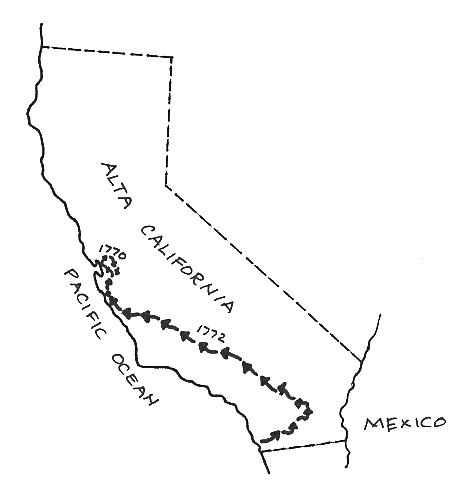| ||||
|
| ||||
|
PEDRO
FAGES
 Lived:
1730-1794
Lived:
1730-1794
Explored California in: 1769-1772
Exploring for: Spain
Explored: by land around San Francisco Bay
The existence of San Francisco Bay was not known to the Spanish until 1769. Explorations over the next few years showed how large the bay was and that it was a useful harbor.
EARLY HISTORY
Pedro Fages was born in Catalonia, a region of northeastern
BACKGROUND
Fages’ explorations in California began in 1769, when he sailed on the San Carlos from La Paz in Baja (Lower) California to San Diego. As part of the Sacred Expedition led by Governor Portolá and Father Serra, Lt. Fages was in charge of a group of 25 soldiers.
When Portolá left San Diego to search for Monterey Bay, Fages
was with him, again as the military leader. After the founding of the Mont
erey presidio (fort) in 1770, Portolá went back to
While Fages was in charge, Father Serra founded three more missions (San Antonio de Padua, San Gabriel, and San Luis Obispo). Fages was not in sympathy with Father Serra’s plans to build more new missions. He turned down Serra’s requests several times, saying that there were not enough soldiers in Alta California to protect more missions.
He also claimed that the mission gardens and orchards were not producing enough food to support the missions and presidios. Indeed, one story tells that Fages organized a grizzly bear hunt near Mission San Luis Obispo, providing meat to feed those at the mission when they were facing starvation.
In 1773 Father Serra went to Mexico City to ask for Fages to be removed from control in Alta California. In response to Serra’s request, Fages was recalled to Mexico City and Captain Fernando Rivera was sent to Monterey in his place.
FAGES’ JOURNEYS
Fages knew about San Francisco Bay because he was with Portolá’s party when they stumbled upon the bay in late 1769. Some months after Portolá left in 1770, Fages went back to the area.
He led expeditions through the Salinas and Santa Clara valleys to the east side of the bay, hoping to find a route to the coast north of the bay. He was exploring along the eastern shore of the bay on November 28, 1770, when he looked across it toward the west and noticed the entrance to the bay from the ocean.
The narrow passage between the two peninsulas (the Marin Peninsula and the San Francisco Peninsula) had not been reported by the captains of ships that sailed along the California coast in the 1500s and 1600s. Perhaps it was the heavy fog that hid it from them. Or perhaps the entrance was so narrow that the islands in the bay and the hills rising on the east side of the bay made it look like a continuous coastline to those on ships passing by.
In March 1772 Fages again led a party from Monterey to explore along the eastern shore of San Francisco Bay. This time Father Juan Crespí was with him, as well as six soldiers, a muleteer, and an Indian guide. They went up the bay through what is now Fremont, Oakland, and Berkeley.
At San Pablo Bay they came to the mouth of the Sacramento River. Unable to get across the Carquinez Strait, Fages went further east into the area of Antioch, Concord, and Walnut Creek. From a hill near Mt. Diablo, Fages saw the great Central Valley to the east. He then went south along the inland valley, returning to San Francisco Bay at the southern end.
Also in 1772, Fages explored a new land route from San Diego to Monterey. He went eastward from San Diego to the desert area, then turned north and crossed the mountains at Tejon Pass. He went through the Antelope Valley and into the San Joaquin Valley, turning back to reach the coast near San Luis Obispo. From there he followed Portolá’s trail along the coast.
WHAT HE ACCOMPLISHED
Fages explored areas away from the coast in California. He was the first to report on the great Central Valley.
LATER YEARS
When he was recalled to Mexico
City in 1774, Fages remained in military duty. In 1781 he led an expedition
to the Colorado River area. The Yuma Indians had rebelled against the Spanish
settlements there, making it impossible for travelers to use the Sonora-California
trail. Fages was successful in subduing the rebellion,
but the trail was not reopened.
In 1782 Fages was appointed governor of Baja and Alta California. At first he governed from Loreto in Baja California, as had previous governors. In 1783 he moved his offices to Monterey in Alta California.
This time Fages brought his wife, Eulalia. She had been born into a high-class family in Catalonia, and she was not prepared for the roughness of life at Monterey. The settlement here was a frontier post. Supplies were often short and contact with the rest of the world was only through the ships that came infrequently.
Despite his wife’s wishes to
go back to